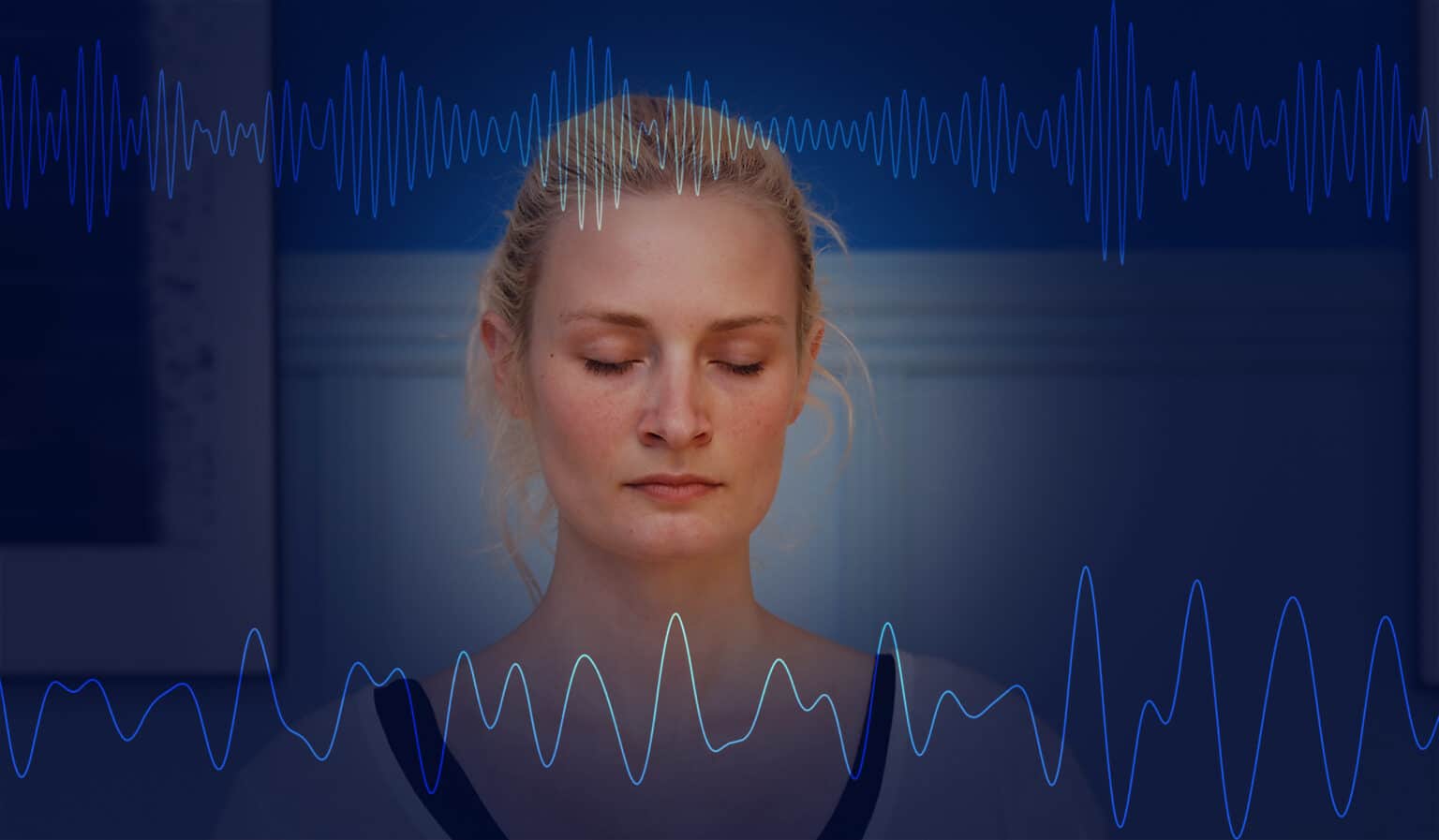What are brainwaves, and what can they tell us about meditation? That is what I am exploring in this intriguing post. As it turns out, understanding brainwaves can give us a better sense of what meditation does and how it acts on different levels of our psyche.
What are brainwaves?
There are about 100 billion neurons or brain cells in our brains. When a neuron transmits a signal, it creates a tiny electrical impulse. They each fire their electrical charge on average 0,16 times per second, producing an immense amount of electrical activity.
As your brain is active, networks of cells synchronise their firing, resulting in a repeating cycle or rhythm. These rhythms are called neural oscillations or brainwaves. In an oscilloscope, the rhythms look like waves, hence the term brainwaves.
The brain’s rhythm changes depending on what information it is processing. This gives rise to a variety of wave types that are associated with distinct states and experiences. The brain produces waves at many different frequencies simultaneously, and different wave types can dominate different parts of the brain.
Scientists measure the amplitude of the neural oscillations in microvolts, which is more precisely a millionth of a volt. The more rapid waves have a lower amplitude than slow ones. The number of discharges per second, the frequency, is measured in hertz (Hz).
How to measure brainwaves during meditation
We can measure brain waves with a device called an electroencephalograph or an EEG. An EEG was used for the first time on a human in 1924. Since then, the technology has been used extensively for research and has been progressively refined. Today, scientists have a vast knowledge of what different brainwaves signify.
To measure neural oscillations, you need to attach electrodes to your scalp. EEG data is very accurate timewise but can’t tell precisely where an electrical impulse arises. However, the more electrodes you have, the easier it is to determine from what part of the brain a specific frequency comes from.
There is another way to study the activity in the brain, and that is by getting images through MRI scans. Yet here the strengths and weaknesses are flipped around. Researchers can pinpoint precisely in what part of the brain activity is going on with an MRI image. However, the exact moment that activity takes place is impossible to determine. That is why EEG and MRI scans are complementary to each other.
Brainwaves and research on meditation
EEGs have been, above all, a tool to study diseases and malfunctions. However, as we will see, a small number of researchers have used the technology to map human consciousness.
Today, with all the interest in meditation research and scientific exploration of consciousness, it is hard to believe that this field used to be off-limits to serious researchers. Nevertheless, in the seventies, studying meditation was a sure way to spoil your career as a scientist.
Different types of brainwaves
When I got into yoga and meditation in the early two-thousands, I learned that there are four primary brain wave frequencies. Nowadays, meditation researchers recognise five distinct wave types, with a few more recently taken up for consideration.
Let’s have a look at the states of consciousness and thought processes associated with each frequency band.
Beta 12 – 40 Hz

Beta activity is crucial as it is the frequency of conscious thought. Our brains work in the lower range of beta to solve problems. Slow beta frequency is where linear thinking takes place as well as writing and calculating. Without beta, you can’t function well in the world. Children with learning disabilities typically display weak beta.
On the other hand, beta waves in the upper range correlate with anxiety, frustration and stress. The higher the amplitude of high range beta waves on an EEG readout, the more stressed you are. In such a state, the blood flow to your prefrontal cortex will be blocked, making you unable to think clearly.
Additionally, negative emotions such as anger, fear, blame, guilt, and shame all produce beta bursts. High beta is also the home of mind chatter. When we meditate the thinking mind calms down and hence beta activity diminishes.
Alpha 8-12 Hz

The alpha frequency is the dominating brain wave when you are in a state of relaxed and detached awareness. It is the rhythm associated with daydreaming and light visualisation. You also pass through an alpha dominated state every evening when you go to sleep and every morning when you wake up. It is called the hypnagogic state.
Scientists early on identified alpha as an essential brain wave pattern in meditation. That is why consumer-grade biofeedback equipment typically focuses on training alpha. However, the meditative state is more complex than that, and efficient meditation will also include other crucial elements. Some scientists define meditation as a combination of alpha and theta activity. However, higher than normal amounts of delta waves is another typical marker of meditation. Advanced practitioners also show gamma activity.
Maxwell Cade was a pioneer EEG researcher who studied among others yogis and healers in the 1970s. He concluded that alpha activity acts as a bridge between the conscious and the subconscious mind.
Cade discovered that no matter how deep you go in your meditations, you can’t recall any of it afterwards unless you have had alpha activity. For the same reason, it is easier to remember your dreams when you are still in the hypnagogic alpha state right after waking up.
Theta 4-8 Hz

Theta is the frequency of the subconscious mind. When we dream, theta is prominent. Theta is also the marker of creativity and intuition, and it is associated with hypnosis and meditation.
Furthermore, theta is a wave type that healers produce when they are healing others. Theta is active no matter what tradition the healer belongs to or the technique used. There is even an exact frequency that tends to dominate in healing, 7,8 Hz, which also happens to be the electrical frequency of planet Earth.
In addition, theta waves correlate with activation of the body’s natural healing capabilities. PhD Dawson Chuch has gone through several dozens of scientific papers on theta and says that there is evidence that supports the following benefits during pronounced theta activity:
- Migration of stem cells
- Enhanced molecular bonding
- Rejuvenation of cartilage
- Increased activity of antioxidants
- Production of serotine
- Reparation of DNA
Delta 1-4 Hz

Delta is the frequency band of the unconscious mind. It is, for example, prevalent in deep restorative sleep. Think of it as the activity that would stay left on if everything else in your system shuts down.
Delta is associated with empathy and psychic awareness. It is also involved in intuition, telepathy, healing and intuitive understanding.
Furthermore, it is a sort of unconscious radar. We are unconsciously scanning the psychic landscape around us with delta.
People in deep meditation have lots of delta waves. Psychics, clairvoyants and mystics do too. However, whether or not large amounts of delta waves are favourable or not depends on your overall composition of brainwave patterns. People suffering from post-traumatic stress can have lots of delta waves. The same goes for highly sensitive people who quickly pick up on other people’s suffering.
Gamma 40 – 100 Hz

Gamma waves take place in the range above the fastest beta waves. They only appear when there is a solid foundation of theta and delta, and it’s only recently that researchers have come to understand their function.
According to Judith Pennington, founder of the Institute for the Awakened Mind, gamma is a governing agent. These waves synchronise the brain across frequencies making it more coherent. In addition, gamma supports the flow of information across the brain’s hemispheres and even the peripheral nervous system. It is associated with peak experiences, high intellectual function and creativity. You could say that gamma is supercharging the brain.
Pennington says that the gamma state is known for neurogenesis, which means the production of new brain cells. In other words, when we are in that state, we increase our capacity for intelligence and memory.
Furthermore, Pennington states that with gamma, we are moving into transpersonal states. This wave pattern is associated with mystical union and access to a spontaneous flow of insight. She says another particularity of gamma is that it makes the lower frequencies more accessible. After meditation with lots of gamma waves, you can readily bring the heightened awareness with you into everyday life.
Epsilon and lambda waves
There are also two recently discovered waves: epsilon and lambda.
Epsilon is the slowest known brainwave frequency. It is working in the range of zero to one Hz, and it can be as quiet as one impulse every ten seconds. Epsilon is associated with a state where the brain resets, with wholeness, integration and deep ecstatic bliss.
Lambda waves are super fast triangular waves. They are in the range of 100-200Hz, and they happen on top of epsilon waves.
Brain wave patterns and meditation
As I have already mentioned, the brain produces all brainwave frequencies simultaneously. What determines our state is the proportions between them. It is eye-opening to look at how meditation changes the ratios between the different frequency bands.
To visualise brainwave patterns, Maxwell Cade invented the Mind Mirror. It’s essentially an EEG that displays the amplitude of each frequency band in two graphs next to each other. One represents the left side or hemisphere of the brain and the other the right. The slowest delta waves are at the bottom of the graph, and the fastest gamma waves are on top.
Cade found that specific brainwave proportions kept coming up in his studies of yogis and meditators. The following section will explain a few of the typical brain wave patterns known today and how meditation changes your brain waves.
Normal brain function
In case you have never trained your mind, for example with meditation, your brain typically has all frequencies present and shows a balance between the left and right hemispheres. Beta frequencies dominate but there is, in addition, a large base of unconscious delta activity. There is little alpha revealing a disconnection of the conscious mind and the deeper layers of the mind.
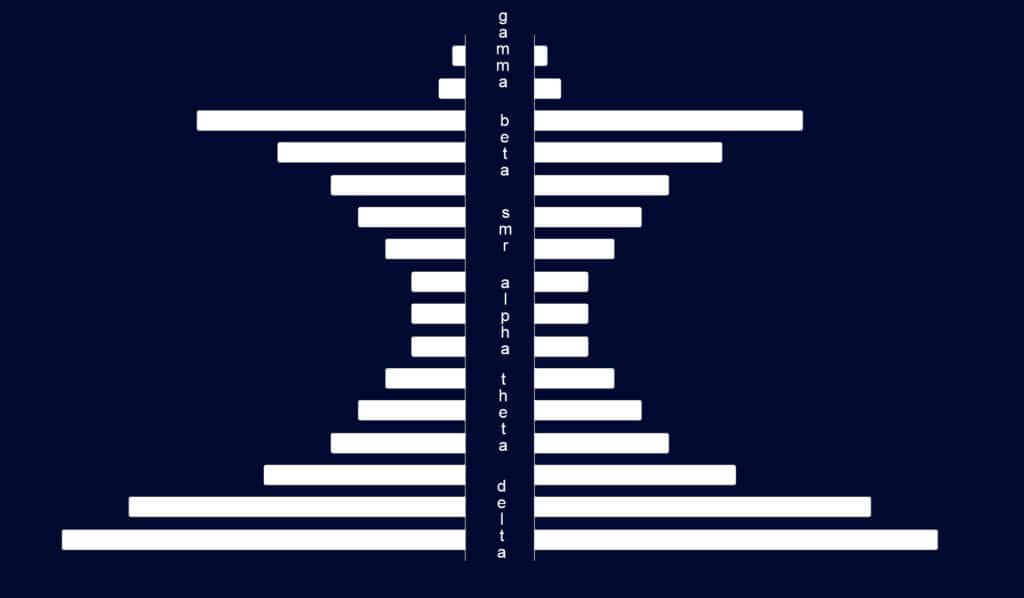
An anxious brain
A person suffering from anxiety has higher than average amplitudes in the beta range with little alpha and theta and much less delta than a healthy person. Here the monkey mind will find worries and problems on an intellectual level. The person is at the same time not in contact with her subconscious intuition and creativity.
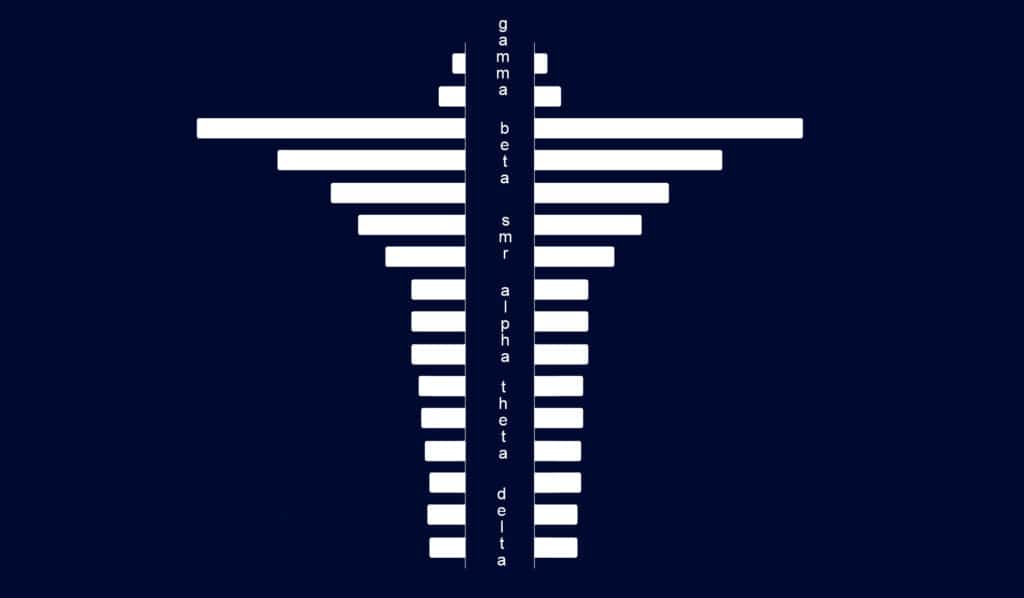
The brainwave pattern of meditation
Now how does the brainwave patterns change when you take up meditation? As a result of meditation, the beta brainwaves of the thinking mind have less energy. Alpha waves become prominent and create a bridge to the activity in the subconscious theta band. This change means that there is now a conscious connection with long term memories, insights and creativity. Unconscious delta waves get amplified, indicating an attraction to psychic connection and empathy.
When there is strong alpha in combination with solid theta, awareness can flow through all brainwave frequencies and related levels of the mind. Relaxed alpha combined with theta gives profound meditations.
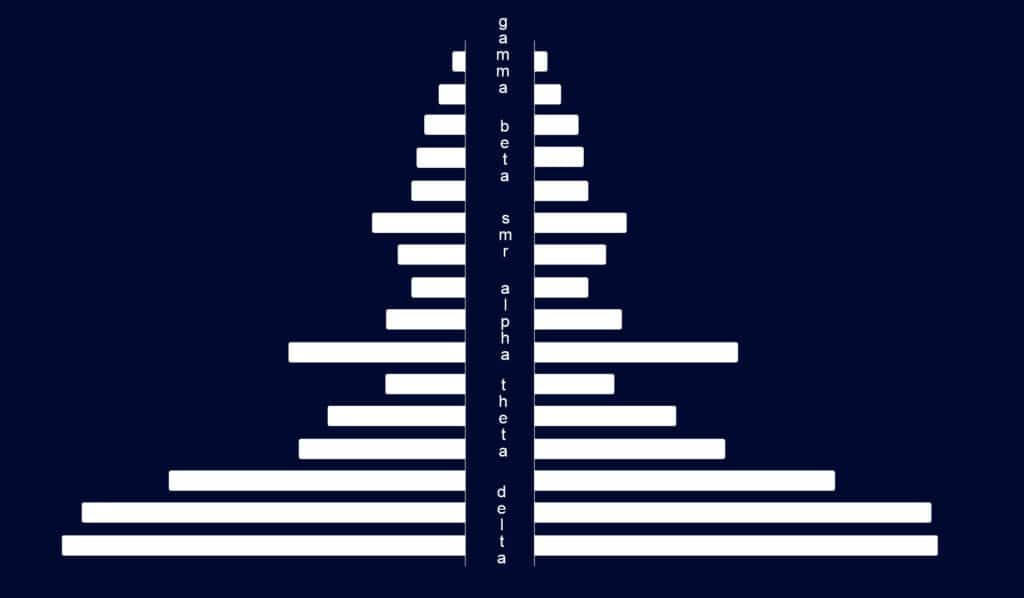
The awakened mind pattern
Maxwell Cade saw a typical wave pattern among the yogis, swamis, and long-term meditators he measured. He called it “the awakened mind pattern”. People living in this brainwave pattern have access to the benefits of each of the primary frequency bands: the clarity of beta, the relaxed awareness of alpha, the creativity, insight, intuition, and spirituality of theta, and the empathy and psychic awareness of delta.
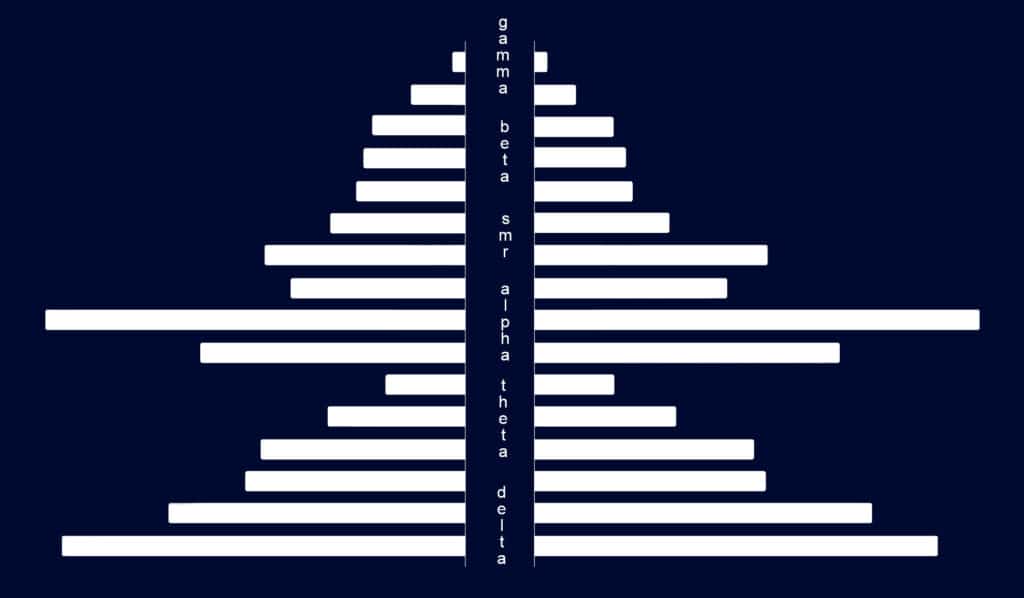
With continuous meditation practice, the alpha bridge becomes solid and lasting. Consequently, the conscious mind is permanently open to more profound levels of the
The Mind Mirror Portal says the following: “The awakened person is creative, spontaneous, happy, enthusiastic, loving, compassionate, non-judgmental, self-actualised, and of service to self and others while living a joyful, fulfilled, and spiritually aware life.”
The evolved mind pattern
But what happens when a person established in the awakened mind pattern sits down to meditate? The next type of brainwave pattern is called the evolved mind pattern. In this state, alpha and theta waves become even stronger and more equal in amplitude.
At the same time, at the bottom of the spectrum, delta activity diminishes. That signifies that unconscious processes flow up to a conscious level. The meditator becomes a fully aware person.
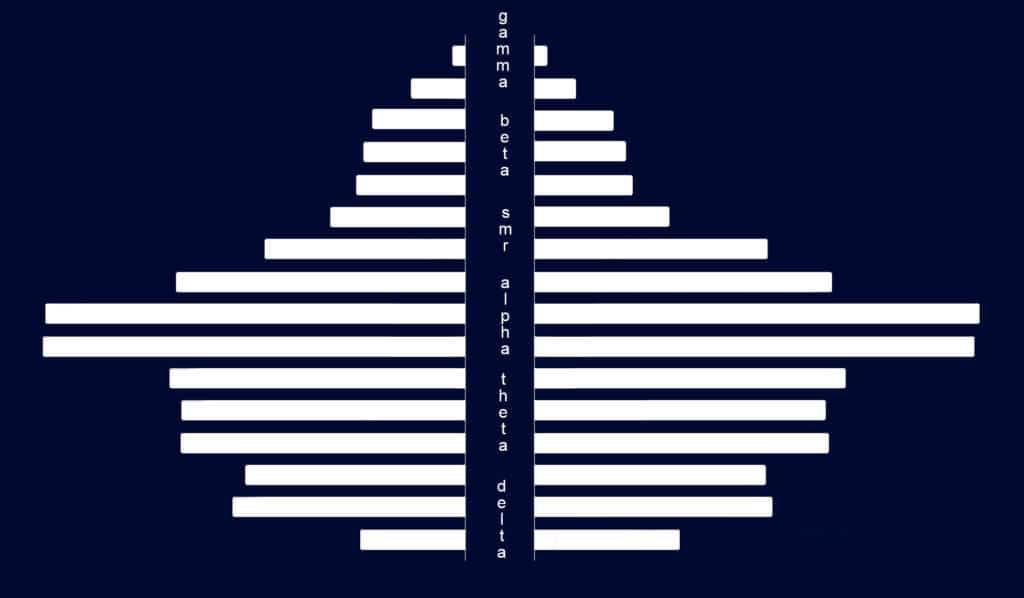
From the Mind Mirror Portal: “This pattern appears when the ego surrenders to an open-hearted connection with the non-local field of the collective unconscious, universal mind, or God. United with itself, merged with the field, the Evolved Mind is a blissful state of absolute knowing that all is one. This is the non-dual pattern of oneness and mystical union which opens to enlightenment.”
Supercharged patterns
The brainwave patterns of advanced meditators can go even further thanks to the presence of gamma waves. When gamma waves happen on top of the awakened mind pattern or the evolved mind pattern, they become supercharged. The gamma synchronises the brain, making it function on a yet higher level.
Gamma activity on top of the evolved mind pattern is the highest brainwave pattern known, and it is rare. People who produce this pattern sometimes lose all sense of the physical world and enter a state with no sense of a separate self.
Key takeaways
- There are five recognised types of brain waves that are all associated with different states and thought processes.
- All wave types are present simultaneously. It is the proportions between the wave types that reveal what state we are in.
- The pattern of your brainwaves changes from meditation. Alpha and theta waves get activated while beta calms down. However, delta waves are also prominent during meditation. In addition, gamma is typically present in advanced meditators.
- Thanks to regular meditation, our EEG profile changes. Meditators often show the awakened mind pattern in which you get the benefits from all frequencies.
- More advanced meditators show diminished unconscious activity in the delta range, which signifies that unconscious processes get pushed up to a conscious level.
- Top-level meditators show gamma activity that powers up the brain by making its parts and different frequency bands work more efficiently together.
